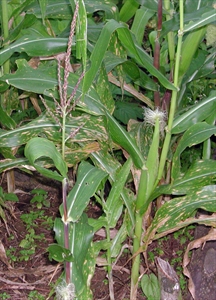Southern leaf blight, southern corn leaf blight, southern leaf spot, maydis leaf blight
Pacific Pests, Pathogens, Weeds & Pesticides - Online edition
Pacific Pests, Pathogens, Weeds & Pesticides
Maize southern leaf blight (080)
Cochliobolus heterostrophus; this is the name for the sexual stage; the asexual stage is known as Bipolaris maydis (previously, it was Drechslera maydis and before that Helminthosporium maydis). There are different races.
Asia, Africa, North, South and Central America, the Caribbean, Europe, Oceania. It is recorded from American Samoa. Australia, Fiji, French Polynesia, Guam, Marshall Islands, New Caledonia. New Zealand, Niue, Papua New Guinea, Samoa, Solomon Islands, Tonga, and Vanuatu.
Maize, including sweet corn, is the main host. The fungus also infects sorghum and many grasses.
The spots start on the lower leaves; at first, they are oval, but become rectangular, up to 2.5 cm long and 2-6 mm wide, confined by the leaf veins (Photo 1). They are light brown with a darker brown margin. The spots grow together, so that large areas of the leaves dry up and die (Photo 2).
The fungus produces large numbers of spores on the leaf spots, and these are spread by wind and rain-splash between plants. The disease is worse on plants growing under shade, and when there are frequent rain showers.
The fungus survives in seed between crops (Race T), but there is no evidence for spread in seeds by Race O. Survival between crops also occurs on volunteer maize plants and grasses, although the importance of grasses is not clear. The fungus survives in infected crop debris, producing spores, which are spread in wind and rain to new crops.
The fungus causes severe damage depending on the weather conditions, race, and the varieties grown. Damage is worse if infection occurs before the silky tufts of long hairs ('stigmas') appear, and temperatures and humidity are high as the ears of maize are produced.
There is no information on the loss of yield caused by this disease in Pacific island countries, but it is unlikely to be high, as the varieties grown will have been bred for resistance to the disease. In the 1970s, in the US and elsewhere, a strain of the fungus (Race T), caused an epidemic, and resulted in ear rot, ear drop and lodging, and a large loss of yield. Race O is the common strain in the tropics and causes minor crop loss.
The Race T infects seeds, causing a dark rot, at the tip. Infected seedling die within 3-4 weeks. Race O is also seedborne, although percentage infection is much less than Race T.
Look for the pale brown spots, at first on the lower leaves, oval, later rectangular, and rapidly joining together, destroying the leaves.
CULTURAL CONTROL
Before planting:
- Do not grow maize on the same land, one crop after another.
- Remove volunteer maize and/or sweet corn plants.
During growth:
- Grow maize and sweet corn in the open (as opposed to being completely surrounded by forest), and provide adequate soil fertility by adding manures (animal or plant), mulches or synthetic fertilizer.
- Plant at wider than normal spacing to reduce humidity in the crop.
After harvest:
- Collect leaves, stalks, and other debris, and use to make compost, or feed to livestock, rather than leaving them in the field to produce spores to infect new crops.
- If not removed, then plough crop remains into the soil.
RESISTANT VARIETIES
Acceptable levels of resistance are available in most varieties grown in the tropics, and this is the main method of managing the disease.
CHEMICAL CONTROL
Fungicides should only be considered in the unlikely event that resistant varieties are unavailable. Apply when the lesions first appear, and repeat if necessary depending on the weather conditions during the growing period. Mancozeb and chlorothalonil are recommended. Seed treatments are not advisable.
____________________
When using a pesticide, always wear protective clothing and follow the instructions on the product label, such as dosage, timing of application, and pre-harvest interval. Recommendations will vary with the crop and system of cultivation. Expert advice on the most appropriate pesticide to use should always be sought from local agricultural authorities.
AUTHORS Helen Tsatsia & Grahame Jackson
Information from Souther corn leaf blight. Wikipedia. (https://en.wikipedia.org/wiki/Southern_corn_leaf_blight); and CABI (2019) Cochliobolus heterostrophus (southern leaf spot). Invasive Species Compendium. (https://www.cabi.org/isc/datasheet/14689); and Pereira J (2014) Bipolaris maydis. BugwoodWiki. (https://wiki.bugwood.org/Bipolaris_maydis). https://wiki.bugwood.org/Bipolaris_maydis); and from McKenzie E (2013) Bipolaris maydis: PaDIL - http://www.padil.gov.au.
Produced with support from the Australian Centre for International Agricultural Research under project PC/2010/090: Strengthening integrated crop management research in the Pacific Islands in support of sustainable intensification of high-value crop production, implemented by the University of Queensland and the Secretariat of the Pacific Community.





